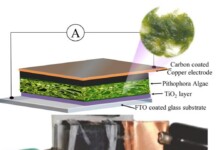In May 2013, hundreds of Wipro staff saw a spectacular sight. They saw thousands of migratory butterflies on their semi-annual journey from Western Ghats to Eastern Ghats rest in their new campus in Electronic City, Bengaluru, for nearly a month, to rest and feed. Why did they go there and not anywhere else?
It happened because Wipro broke the norm. Instead of laying out thousands of square feet of lush green lawns, it adopted a biodiversity policy a few years ago. It planted 2849 trees and several hundreds of small native fl owering plants.
That’s not all. Wipro staff photographed gorgeously colored Golden Backed Ant, Rhino Beetle, native to Bannerghatta forest range. It is endangered and usually breeds on elephant dung. They found tiny frog with cryptic coloration including 15 bird species and 23 species of butterfl y, all in their campus. “Our campus has created a sense of wonder and renewed energy among employees,” says P S Narayan, VP and head of Sustainability, Wipro Ltd. Now, Wipro has taken this to the next level. It is using biodiversity as a platform for employee engagement.
It has identified biodiversity champions and conducts expert workshops covering biodiversity principles, forests and communities, urban ecology, among others. It organizes general town hall gatherings on Earth Day and wildlife week. It has even created a portal for employees to upload images and share experiences.
Wipro is among a few pioneers among IT companies that have taken to campus biodiversity very seriously. This is one of the many ways companies are cutting their carbon footprint and bringing the employees closer to nature.
Chaotic Abundance of Biodiversity
The grass lawns, of late, have become somewhat associated with the moods of people depending how well they are doing fi nancially. A critic of lawns in the United States said: “There is nothing remotely natural about a lawn. It is an industrial landscape disguised as organic plant material.”
The lawn has its roots in England. It makes sense there because of regular rainfall and cool climate. But people wonder why in an extremely diverse country like the US more grass is grown in lawns than any other crop, estimated to be more than whopping thirty million acres.
There’s been a quiet movement in the US to replace domestic front lawn with an edible landscape. The Edible Estates project, for example, proposes that the food grown in front yards connects people to seasons, the organic cycles of the earth, and neighbors.
“The banal lifeless space of uniform grass in front of the house can be replaced with the chaotic abundance of biodiversity. In becoming gardeners we will reconsider our connection to the land, what we take from it, and what we put in it. Each yard will be a unique expression of its location and of the inhabitant and his or her desires,” Freitz Haeg wrote in his post published in AlterNet a few years ago.
Haeg’s views resonate closely with most Indian households who still grow fruits, vegetables and fl owers in their front and backyards. Why then did the builders of monstrous commercial buildings, offi ce campuses and residential buildings in big Indian cities move away from the Indian way of life to laying out lawns?
The post 2000 India is when Indian companies became big and needed huge campuses. The only way they could ramp up was to emulate western campuses. And the first ones to build such large campuses in India were multinational companies who used to take pride in replicating their office culture wherever they went. This had a fall out even in residential complexes in cities like Bengaluru, Gurgaon, Pune and Chennai.
The lawn vs. biodiversity debate is ten years old in the West and perhaps two years young in India. The pitfalls of using lawns are well documented – needing exorbitant amounts of scarce water and lavish use of chemical fertilizers for their maintenance. The fertilizer and chemicals get into the water table, tanks and lakes contaminating them as well. A spokesperson of Mantri Developers, a prominent builder in Bengaluru, says: “The cost of lawn is cheaper (by `50%) when compared to ground cover with local species. However, in the long run, the maintenance (cost) of lawn is more than the ground covers and also the water consumption is also more.
The ground cover (plants and trees) require 1/5th of the lawn water. (Yet) The lawn is preferred because of its low installation cost and looks green from the day one of installation and gives a great feeling.” The builders’ version of ‘great feeling’ may be changing with greater awareness about biodiversity among children and the possibility of urban forestry minimizing the damage city’s pollution causes. A city’s greenbelt need not be outside the city, as it used to be. It can be within and inside our own campuses and homes.
Urban Forest
Fortunately, builders and buyers need not break their heads about how to do this. Shubhendu Sharma’s startup Afforest (www.afforestt.com) promises to raise an urban jungle in eight months, literally. His reforestation company uses a revolutionary planting method that enables it to transform a barren area the size of six parking spaces into a 300 tree forest in just eight months. Here the tree grows ten times faster than it would take using traditional methods.
There’s another terrific option for companies and residential complexes to raise oxygen levels by planting Assamese bamboo. Infosys has tried this and is happy it has done so to offset its travel related emissions. Also called Bheema Bamboo, this wonder plant, developed by Hosurbased Growmore Biotech (www. growmorebiotech.com), is capable of absorbing 50 kilograms of carbon dioxide in a year, which is approximately fi ve times that of most plants. It grows about one foot a day for a month during monsoon and in two years reaches 60 feet.
This plant promises to transform India’s renewable energy sector, provide environment-friendly wood for the paper industry and also help reclaim lost forest cover in two years. It also has the potential to become the energy crop of the developing world.
The ratio of lawns to plants is currently 70 and 30 percent. This could be reversed easily in new facilities and gradually in the older ones. The good news is, everyone is a winner in this shift, including the humble blades of grass which certainly would prefer to have their day in the sun. What are we waiting for?










